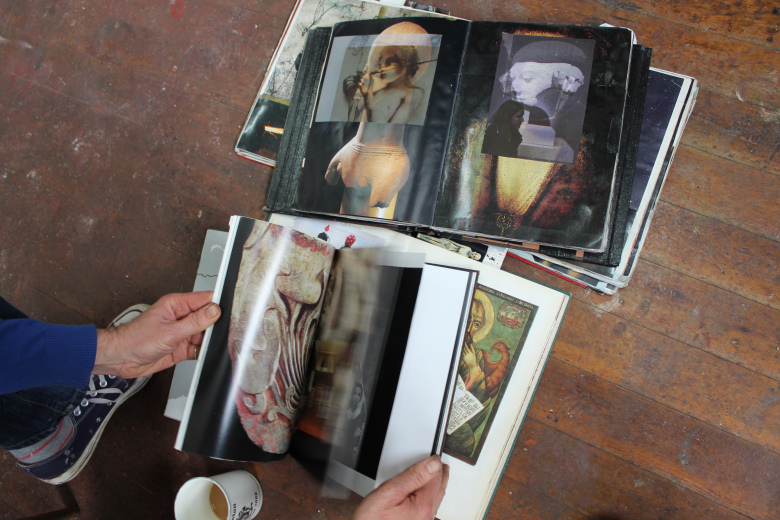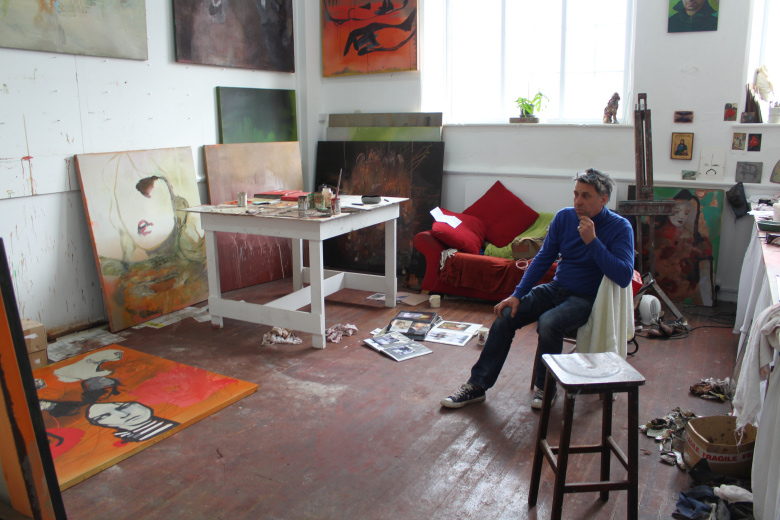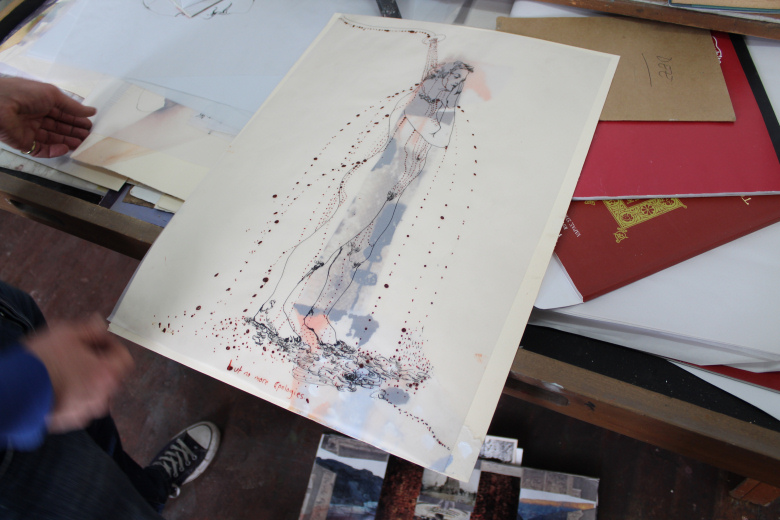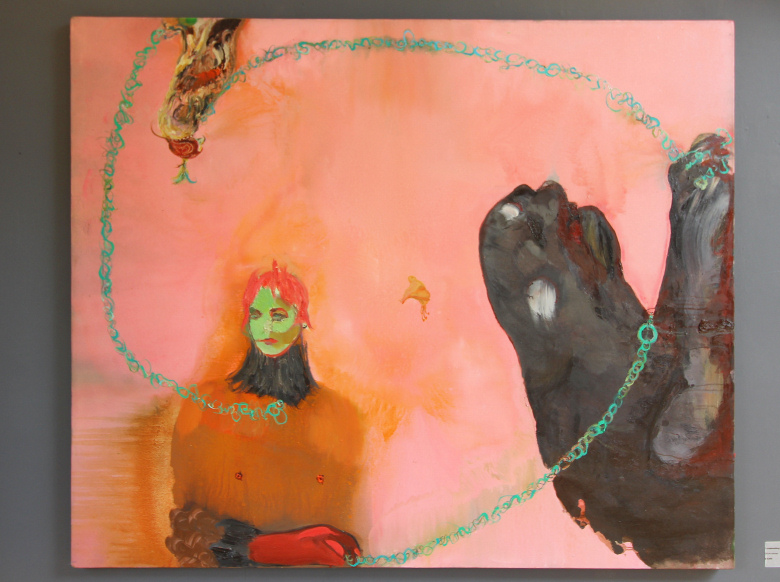|
Being Two
Things: Jesse Leroy Smith and his ‘Force Majeure’
Kate Reeve-Edwards
On entering Jesse Leroy Smith’s studio, the first impression is that of
faces. Faces made strange, faces out of photographs, faces in a line;
faces layered on top of faces in a raucous assertion of humanity, in all
its difficulty. The figure, and its distortion is, of course, an
essential part of Leroy Smith’s work, and what makes it instantly
recognisable. Yet, as a young man the artist identified as an abstract
painter, being influenced by his travels to different countries and the
melange of the exhilarating experiences of youth. As Leroy Smith is
inspired by his environment, the content of his work went through a
natural shift once the rhythm of how he lived changed. Marriage and
children altered his life and altered his painting; figures became its
foundation. He was not exposed to new things or novel places as much,
but his family became a richer focus.

Change is so much of what
Leroy Smith’s work is about, so it’s poignant that this is at the root
of its conception. It is important to note, the abstraction that came
from youth is not at all lost; it has metamorphosed (an apt term for
someone interested in the works of Ovid) and joined with the figurative.
The viewer is presented with two layers that converse interestingly,
often seeming to feud within the canvas, but always working together to
create an overall feeling. Technically we see this too. Leroy Smith was
classically trained, gaining his post graduate degree from the Royal
Academy, and he still enjoys careful figurative observation, spending
hours at art galleries in Greece drawing classical statues and figures
from Renaissance painting. The abstraction often becomes a distorting
force, as if it is seeping through the canvass, through the figures,
creating an entirely different feeling of emotional weather. It is this
duality, this ‘being two things’, as the artist puts it, that creates
the centre of his work, and his show ‘Force Majeure’.
It is this value of different perspectives that draws the artist to
collaboration. The RA tutors who opened up the art world to him through
vocalising opportunity, made a positive impression on Leroy Smith. The
artist values outsider input, acknowledging that a different perspective
can germinate interesting results. This was seen within the
collaborative exhibition of experimental work ‘Suspended Sentences’,
inspired by the poetry of Simon Armitage. Leroy Smith explained that,
although he enjoys Armitage’s poetry, it was Mark Spray who drove forth
the idea, being intensely inspired by the poet. He elucidated that it
was useful and creative to have someone else’s process inform his own.
This reasoning is behind the involvement of Sasha Craddock in the
curation of ‘Force Majeure’. Having taken Craddock on as a long-term
mentor, he values her choices, understanding that her decisions offer a
more expansive view of what the work does within the space. It cuts
through the artist’s needs and attachments to specific pieces, and
allows for a bigger picture to be presented.

His interest in collaboration with young artists has become part of his
practise. As Leroy Smith has an interest in faux-naive or ‘outsider’
art, as a point of contrast with more carefully constructed work, young
people’s responses to new processes energise him as an artist. With
younger artists, there is an emphasis on the immediate in the way the
paint is laid down, he suggests, ‘you can approach work from an academic
and technique-oriented point of view but it is so refreshing and
exciting to see a young artists reaction to something they have never
done before.’ Leroy Smith enlisted his son to co-paint some of his work
for ‘Force Majeure’, for this very reason. As an artist, he is
interested by father/ children relationships, so it was important to
have this physically represented within his work. He became inspired by
the direct nature of his son’s painting and the confident, unexpected
results it produced. This collaboration extends his works duality.
Having his son contribute to his work brought in an element out of his
control, an extension of the abstract and chaotic parts of his work;
although he allows and enjoys his son’s more peppy style, the artist is
still very prescriptive about colour and positioning, which similarly an
extension of his work’s more considered, figurative elements.
This familial importance goes deeper; Leroy Smith has dozens of
hand-made sketchbooks which he encouraged his children to draw and write
in from an early age. The artist and his family have always had a strong
link to Greece, visiting this hub of antiquity, myth, and history, at
least once a year, with Athens being the main place of interest for
Leroy Smith. The sketchbooks document the familial creativity produced
over these holidays; the children responding to classical forms with
wonderfully naive and playful drawings, layering over pensive figure
sketches by Leroy Smith, like the graffiti scrawled by Byron over
Poseidon’s Temple. These sketchbooks are loosely held together, falling
away at the binding; chaotic and beautiful, made to represent Athens
itself. Although ‘Force Majeure’ is a show that was created in a very
short space of time with a specific focus, his work does correlate
directly to the formative drawings and collages he made in these
sketchbooks years beforehand. One particular painting is almost visually
verbatim from a collaged set of sketchbook images showing his daughter’s
face, a pair of poppies, and two statues of lions. These sketchbooks and
the artistic interaction with his children affect his work directly;
this love of collaboration is set within the pieces that were not
touched by any hand other than the artists own.

‘Force Majeure’ is the first solo show Leroy Smith has done for a
decade. The tumultuous life-circumstances experienced over the past 5/ 6
years meant he could not comprehend putting together an exhibition until
now. The work within it, although not created over the past ten years,
shows the metamorphosis and difficulties he has come across during this
time. This is why it is a ‘Force Majeure’: it shows the disruptive
events of life. Therefore, the artist sees it as more than just a
‘show’, it is ‘something more important than that’, a landmark, a
return.
This is a show about humanity, about living, about loving, about how
neither are straightforward, happy, or easy. ‘Life is a barrage of
stuff: love, anger, frustration, loss. The show is an attempt to make
sense of it or at least depict the chaos and live in it, to celebrate
the fight.’ This ‘fight’ happens in the very materials of the painting;
Leroy Smith treated the canvass like an abstract painting in itself,
letting the paint do things out of his control: slathering it onto the
back of the canvass and allowing it to bleed through, pouring and
dripping it to create unexpected results. He understands paint in itself
as disobedient, saying ‘the struggle is exhilarating.’ Yet, he layers
over this with thoughtful drawings that demonstrate his classical
background. This layering is something he stumbled upon accidentally;
Smith did a studio swap in Berlin to completely reinvent his process,
deciding not to take any materials with him apart from a pen. ‘Sometimes
after being an artist for many years you get stuck, so you often have to
collapse everything and start again, before ending up in the same
place.’ Whilst on the swap, he needed something to draw on whilst
visiting a gallery. He found some tracing paper and used it as a
sketch-pad, and once back at his studio he was excited by the effect of
layering these transparent concentrated drawings over more abstract
pieces. It is this that he expanded upon to create this show. For the
viewer, the foreground of the figurative and the beautiful allows us a
‘way in’ to the chaotic and the emotional. It is the unruly and the
defiant, paired with controlled sophistication that is ‘this idea of
being two things.’

As someone who is fascinated
by the intertextuality of culture, and how everything we consume creates
who we are, I was interested in how Leroy Smith’s other creative
interests fed into his work. His fascination with Renaissance painting
and the religious or mythic stories they depict is evident in his
paintings. He told me he was resoundingly effected by a fresco in Turkey
he saw twenty years ago; the eyes of the priests had been scratched out
by Muslim believers. The Christian narrative disturbed them so much that
they had to physically destroy it, showing they recognised the religious
iconography as having enormous power, ‘so destruction and anger becomes
a kind of homage.’ We can apply this logic to this show; depicting the
destruction and turmoil of the artists life acts also as an homage to
it.
This interest in revered classical art is contrasted by a love of dance
music, especially that of ‘Underworld’, ‘LCD Sound System’, and ‘The
Velvet Underground’. These three bands in themselves accomplish dualism;
the records are split between beautiful, tender, lyrical songs, and
powerful, raunchy, avant-garde dance music. He paints to these artists,
drawing their sounds into his work. A marriage of Leroy-Smith’s two
states is perhaps in the closing image he gave me: one of him sitting in
a Greek art gallery creating pensive studies in a transient state of
focus, whilst these heavy and chaotic dance tracks play in his head. So,
he is always ‘being two things’, right down to his solitary moments. The
sophisticated and the bacchanalian are all human beings are really: the
Id and the superego, the rational and the sub-conscious, all battling to
be the focus of our image. It is this that Leroy Smith shows us, which
is why his work connects to so many; it is entirely, truthfully,
painfully, human.
Kate
Reeve-Edwards' blog is at
https://culturalcapital2019.wordpress.com/ & instagram
@culturalcapital2019
see
'interviews' for interview with
Jesse Leroy Smith.
Jesse Leroy
Smith's Force Majeure is at Tremenheere until 23.6.19
|




